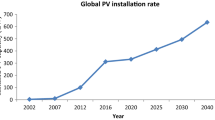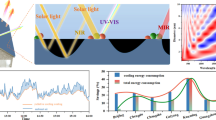Abstract
Dust accumulation is one of the reasons for the performance degradation of concentrating photovoltaic and thermal (CPV/T) systems due to the deposition of dust particles with different compositions, shapes, sizes, and masses. In this work, an optical model was developed to investigate the influence of the particle size, diameter, shape, and deposition density on the light concentration efficiency, using the Monte Carlo raytracing (MCRT) method in the Tracepro software. The triangular particles had a larger influence on the light ray deflection and energy flux degradation than the circular and square particles. An average increase in the dust density of 1 g/m2 decreased the light concentration efficiency of particles with sizes smaller than 50 µm and 60 µm by 3.31% and 3.26%, respectively. Furthermore, the effect of the incidence angle on the light concentration efficiency was considered at an angle less than 2°.
Similar content being viewed by others
Abbreviations
- CFD:
-
Computational fluid dynamics
- CPV:
-
Concentrating photovoltaic
- CPV/T:
-
Concentrating photovoltaic and thermal
- CSP:
-
Concentrating solar power
- EDS:
-
Energy Dispersive X-ray Spectroscopy
- MCRT:
-
Monte Carlo ray-tracing
- MS:
-
Markov regime-switching
- PMMA:
-
Polymethyl methacrylate
- PV:
-
Photovoltaic
- PVC:
-
Polyvinyl chloride
- PV/T:
-
Photovoltaic and thermal
- RMSE:
-
Root mean square error
- SEM:
-
Scanning Electron Microscopy
- SOG:
-
Silicon on glass
- XRD:
-
X-ray powder diffraction
- η c :
-
light concentration efficiency before dust accumulation/%
- η d :
-
light concentration efficiency after dust accumulation/%
- η loss :
-
the loss rate of the light concentration efficiency/%
- η r :
-
dust coefficient/%
- ρ ave :
-
average dust density/g·m−2
- ω :
-
density of dust particles/g·m−3
- Eave :
-
average irradiance/W·m−2
- E max :
-
maximum irradiance/W·m−2
- E min :
-
minimum irradiance/W·m−2
- m :
-
the mass of the dust/g
- n :
-
total number of experiments
- S :
-
the area of the Fresnel lens/m2
- T avg :
-
mean transmittance value/%
- T e :
-
experimental transmittance value/%
- V :
-
volume of the accumulated dust/m3
References
Figgis B., Ennaoui A., Ahzi S., Rémond Y., Review of PV soiling particle mechanics in desert environments. Renewable and Sustainable Energy Reviews, 2017, 76: 872–881.
Renno C., Thermal and Electrical Modelling of a CPV/T System Varying Its Configuration. Journal of Thermal Science, 2019, 28: 123–132.
Griffith DJ., Vhengani L., Maliage M., Measurements of mirror soiling at a candidate CSP site. Energy Procedia, 2014, 49: 1371–1378.
Siddiqui R., Bajpai U., Correlation between thicknesses of dust collected on photovoltaic module and difference in efficiencies in composite climate. International Journal of Energy and Environmental Engineering, 2012, 3: 26–33.
Jin Y., Fang J., Wei J., Qaisrani MA., Wang X., Thermal performance evaluation of a cavity receiver based on particle’s radiation properties during the day time. Renewable Energy, 2019, 143: 622–636.
Kalogirou S.A., Agathokleous R., Panayiotou G., On-site PV characterization and the effect of soiling on their performance. Energy, 2013, 51: 439–446.
Goswami D.Y., Vijayaraghavan S., Lu S., Tamm G., New and emerging developments in solar energy. Solar Energy, 2004, 76: 33–43.
Abdolzadeh M., Nikkhah R., Experimental study of dust deposition settled over tilted PV modules fixed in different directions in the southeast of Iran. Environmental Science and Pollution Research, 2019, 26(30): 31478–31490.
Jesus MAML de, Timò G., Agustín-Sáenz C., Braceras I., Cornelli M., Ferreira A de M., Anti-soiling coatings for solar cell cover glass: Climate and surface properties influence. Solar Energy Materials and Solar Cells, 2018, 185: 517–523.
Kazem H.A., Chaichan M.T., The effect of dust accumulation and cleaning methods on PV panels’ outcomes based on an experimental study of six locations in Northern Oman. Solar Energy, 2019, 187: 30–38.
Maghami MR., Hizam H., Gomes C., Radzi MA., Rezadad MI., Hajighorbani S., Power loss due to soiling on solar panel: A review. Renewable and Sustainable Energy Reviews, 2016, 59: 1307–1316.
Sayyah A., Horenstein MN., Mazumder MK., Energy yield loss caused by dust deposition on photovoltaic panels. Solar Energy, 2014, 107: 576–604.
Darwish Z.A., Kazem H.A., Sopian K., Al-Goul MA., Alawadhi H., Effect of dust pollutant type on photovoltaic performance. Renewable and Sustainable Energy Reviews, 2015, 41: 735–744.
Ferrada P., Olivares D., del Campo V., Marzo A., Araya F., Cabrera E., et al., Physicochemical characterization of soiling from photovoltaic facilities in arid locations in the Atacama Desert. Solar Energy, 2019, 187: 47–56.
Wu Z., Yan S., Wang Z., Ming T., Zhao X., Ma R., et al., The effect of dust accumulation on the cleanliness factor of a parabolic trough solar concentrator. Renewable Energy, 2020, 152: 529–539.
Salari A., Hakkaki-Fard A., A numerical study of dust deposition effects on photovoltaic modules and photovoltaic-thermal systems. Renewable Energy, 2019, 135: 437–449.
Lu H., Zhang L.Z., Influences of dust deposition on ground-mounted solar photovoltaic arrays: A CFD simulation study. Renewable Energy, 2019, 135: 21–31.
Hachicha A.A., Al-Sawafta I., Said Z., Impact of dust on the performance of solar photovoltaic (PV) systems under United Arab Emirates weather conditions. Renewable Energy, 2019, 141: 287–297.
Boyle L., Flinchpaugh H., Hannigan MP., Natural soiling of photovoltaic cover plates and the impact on transmission. Renewable Energy, 2015, 77: 166–173.
Pan A., Lu H., Zhang L.Z., Experimental investigation of dust deposition reduction on solar cell covering glass by different self-cleaning coatings. Energy, 2019, 181: 645–653.
Al-Hasan A.Y., A new correlation for direct beam solar radiation received by photovoltaic panel with sand dust accumulated on its surface. Solar Energy, 1998, 63: 323–333.
Wang H., Meng X., Chen J., Effect of air quality and dust deposition on power generation performance of photovoltaic module on building roof. Building Services Engineering Research and Technology, 2020, 41: 73–85.
Alnasser T.M.A., Mahdy A.M.J., Abass K.I., Chaichan M.T., Kazem H.A., Impact of dust ingredient on photovoltaic performance: An experimental study. Solar Energy, 2020, 195: 651–659.
Kaldellis J.K., Kapsali M., Simulating the dust effect on the energy performance of photovoltaic generators based on experimental measurements. Energy, 2011, 36: 5154–5161.
Chanchangi Y.N., Ghosh A., Sundaram S., Mallick T.K., An analytical indoor experimental study on the effect of soiling on PV, focusing on dust properties and PV surface material. Solar Energy, 2020, 203: 46–68.
Beattie N.S., Moir R.S., Chacko C., Buffoni G., Roberts S.H., Pearsall N.M., Understanding the effects of sand and dust accumulation on photovoltaic modules. Renewable Energy, 2012, 48: 448–452.
Dahlioui D., Laarabi B., Barhdadi A., Investigation of soiling impact on PV modules performance in semi-arid and hyper-arid climates in Morocco. Energy for Sustainable Development, 2019, 51: 32–39.
Kazem H.A., Chaichan M.T., Experimental analysis of the effect of dust’s physical properties on photovoltaic modules in Northern Oman. Solar Energy, 2016, 139: 68–80.
Parrott B., Carrasco Zanini P., Shehri A., Kotsovos K., Gereige I., Automated, robotic dry-cleaning of solar panels in Thuwal, Saudi Arabia using a silicone rubber brush. Solar Energy, 2018, 171: 526–533.
Tanesab J., Parlevliet D., Whale J., Urmee T., Seasonal effect of dust on the degradation of PV modules performance deployed in different climate areas. Renewable Energy, 2017, 111: 105–115.
Hachicha A.A., Al-Sawafta I., Ben Hamadou D., Numerical and experimental investigations of dust effect on CSP performance under United Arab Emirates weather conditions. Renewable Energy. 2019, 143: 263–276.
Mehmood U., Irshad H.M., Al-Sulaiman F.A., Bashir S., Yilbas B.S., Effect of Accumulation of Environmental Dust and Subsequent Mud Formation on Textural, Chemical, and Optical Properties of Silicon Wafers for Photovoltaic Cells. IEEE Journal of Photovoltaics, 2018, 8: 1274–1280.
Buseck P.R., Pósfai M., Airborne minerals and related aerosol particles: Effects on climate and the environment. Proceedings of the National Academy of Sciences of the United States of America, 1999, 96: 3372–3379.
Ghazi S., Sayigh A., Ip K., Dust effect on flat surfaces — A review paper. Renewable and Sustainable Energy Reviews, 2014, 33: 742–751.
Mishra S.K., Agnihotri R., Yadav P.K., Singh S., Prasad M., Praveen P.S., et al., Morphology of atmospheric particles over semi-arid region (Jaipur, Rajasthan) of India: Implications for optical properties. Aerosol and Air Quality Research, 2015, 15: 974–984.
El-Shobokshy M.S., Hussein F.M., Effect of dust with different physical properties on the performance of photovoltaic cells. Solar Energy, 1993, 51: 505–511.
Heimsath A., Nitz P., The effect of soiling on the reflectance of solar reflector materials — Model for prediction of incidence angle dependent reflectance and attenuation due to dust deposition. Solar Energy Materials and Solar Cells, 2019, 195: 258–268.
Renno C., Landi G., Petito F., Neitzert H.C., Influence of a degraded triple-junction solar cell on the CPV system performances. Energy Conversion and Management, 2018, 160: 326–340.
Imtiaz Hussain M., Lee G.H., Experimental and numerical studies of a U-shaped solar energy collector to track the maximum CPV/T system output by varying the flow rate. Renewable Energy, 2015, 76: 735–742.
Wu G., Yang Q., Zhang Y., Fang H., Feng C., Zheng H., Energy and optical analysis of photovoltaic thermal integrated with rotary linear curved Fresnel lens inside a Chinese solar greenhouse. Energy, 2020, 197: 117215.
Li G. Design and development of a lens-walled compound parabolic concentrator-a review. Journal of Thermal Science, 2019, 28: 17–29.
Yan S., Zhao S., Ma X., Ming T., Wu Z., Zhao X., et al., Thermoelectric and exergy output performance of a Fresnel-based HCPV/T at different dust densities. Renewable Energy, 2020, 159: 801–811.
Katzan C.M., Edwards J.L., Lunar dust transport and potential interactions with power system components. NASA Contractor Report 4404, 1991.
Liang H., Fan M., You S., Zheng W., Zhang H., Ye T., et al., A Monte Carlo method and finite volume method coupled optical simulation method for parabolic trough solar collectors. Applied Energy, 2017, 201: 60–68.
Feng G., Li P., He Y., Wang Y., Wu H., Uncertainties evaluations in the ray-tracing algorithm based on Monte Carlo method. 7th International Symposium on Advanced Optical Manufacturing and Testing Technologies: Design, Manufacturing, and Testing of Micro- and Nano-Optical Devices and Systems, 2014, 9283: 92830Y.
Ho W.H., Tsai J.T., Lin B.T., Chou J.H., Adaptive network-based fuzzy inference system for prediction of surface roughness in end milling process using hybrid Taguchi-genetic learning algorithm. Expert Systems with Applications, 2009, 36: 3216–3222.
Jiang H., Lu L., Sun K., Experimental investigation of the impact of airborne dust deposition on the performance of solar photovoltaic (PV) modules. Atmospheric Environment, 2011, 45: 4299–4304.
Meng Q., Wang Y., Zhang L., Irradiance characteristics and optimization design of a large-scale solar simulator. Solar Energy, 2011, 85: 1758–1767.
Bohren C.F., Huffman DR., Absorption and Scattering of Light by Small Particles. Arizona, United States of America, 1998.
Fu L., Leutz R., Annen HP., Evaluation and comparison of different designs and materials for Fresnel lens-based solar concentrators. Nonimaging Optics: Efficient Design for Illumination and Solar Concentration VIII, 2011, 8124: 81240E.
Acknowledgments
This research was supported by the National Natural Science Foundation of China (No.51766012), the Natural Science Foundation of Inner Mongolia (No. 2019MS05025), the Inner Mongolia Science and Technology Major Project (No. 2019ZD014) and the Key Project of the ESI Discipline Development of Wuhan University of Technology (WUT Grant No. 2017001).
Author information
Authors and Affiliations
Corresponding author
Additional information
Special issue: Built Thermal Environment
Rights and permissions
About this article
Cite this article
Zhao, N., Yan, S., Ma, X. et al. Analysis of the Light Concentration Loss of a Fresnel CPV/T System after Dust Accumulation. J. Therm. Sci. 31, 1868–1880 (2022). https://doi.org/10.1007/s11630-021-1466-8
Received:
Published:
Issue Date:
DOI: https://doi.org/10.1007/s11630-021-1466-8




